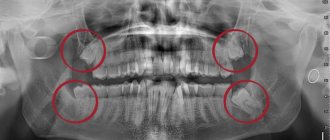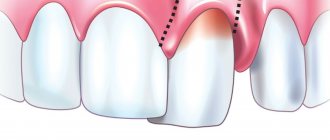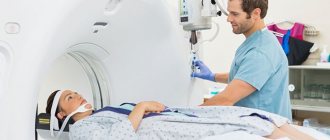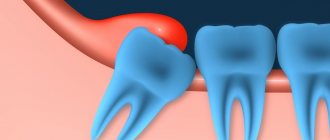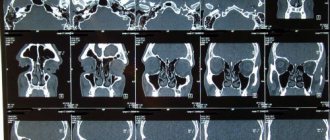2452
Temporomandibular joint dysfunction is a rather complex condition that can be experienced by people of different ages and health conditions.
A large number of different symptoms, difficulties with chewing and opening the mouth are a serious reason to visit the dentist to determine whether a pathology of the lower jaw joint, such as Costen syndrome, is developing.
Description of the problem
Costen's syndrome was discovered in the thirties of the 20th century. Otolaryngologist D. Kosten compared cases of patients complaining of ear pain due to pathologies in the structure of the jaw system, and came to the conclusion that there is a relationship between these factors.
Pathological occlusion syndrome, as Costen's syndrome is otherwise called, is a functional disorder of the temporomandibular joint.
This pathology affects the cartilage disc, which provides joint mobility in three directions, due to which complete chewing of food is carried out.
An unevenly distributed load between the jaws leads to inflammation of the cartilage disc, which can lead to its degeneration if not treated in a timely manner.
As a result of this phenomenon, there is a decrease or complete loss of mobility of the mandibular joint.
Temporomandibular joint dysfunction
What does a doctor who has been working in the “red zone” for two years dream about? What wishes does a woman doctor make for the New Year and how does she see the world after the pandemic? All answers are in an interview with a pulmonologist, head of the Covid department of the Clinical Hospital No. 4, assistant at the Department of Pulmonology of Sechenov University Zamira Merzhoeva.
Zamira Magomedovna, you are one of the first to receive a high state award - the Order of Pirogov.
Behind this assessment of your work - sleepless nights and days are hidden, dedication associated with the risk of life - how do you cope with all the difficulties that befall a doctor working in the “red zone”? Physical fatigue can be dealt with and recovered easily, but the moral costs are much more difficult to compensate for. Even now, when the pandemic seems to have subsided, we work 24/7.
The work of doctors in the “red zone” is often compared to work at the front. It’s not for nothing that a monument to the “Feat of Medical Workers in the Fight against COVID-19” was erected on the territory of Sechenov University. When the pandemic first started, were you scared?
Yes, of course it was scary. I once saw a doctor walking ahead of me, already an adult man, cross himself before entering the “red zone.” This says a lot.
What do you remember now about the very first days of the pandemic?
A line of ambulances near our clinical hospital, an extreme flow of severe patients with shortness of breath, lack of air, respiratory failure. Doctors dressed in such unusual personal protective equipment. You can’t imagine how hard it is to work in overalls - it’s hot, stuffy. But as soon as you enter the “red zone”, you see patients, you no longer think about anything and are not distracted by anything.
Do you spend a lot of time on equipment?
I am the daughter of a military man. My dad taught my sister and me to dress quickly when we were kids. I get dressed in about five minutes, no more. But at first they dressed us and wrote our last name on the back, because we didn’t recognize each other. And now there is no need for inscriptions; we recognize colleagues by their gait and eyes.
Each person's illness progresses individually. And despite the fact that the standards for treating covid patients have been determined, therapy has to be selected for each patient. Does a doctor in the era of personalized medicine listen to his intuition?
No one knows how the human body will behave. It happens that the first CT scan shows a slight damage to the lungs, but the temperature remains and the very next day the damage can grow to 100%. And at the level of experience and intuition - they are inseparable for me - you make a decision on how to act.
Over these two years, Covid has probably broken all records for horror stories and myths. Which absurdity surprised you more than others?
I was not surprised, but most likely upset when they said that the patient came to the hospital on his own legs and died there. It’s difficult to explain to people that we did everything possible to save him. And when relatives accuse doctors of this, I never enter into controversy and do not mention the subtleties of the process. But I always offer my condolences.
What is the hardest thing in the “red zone”?
It’s scary when members of the same family are admitted at the same time. There was a case when a couple was brought to us - he died, she, fortunately, recovered. And the child, although already an adult, 25 years old, wrote: “Thank you for your mother.”
Are simple words of gratitude from patients so important to a doctor?
This is the most expensive reward! All doctors who are involved with Covid know that recovery does not always depend on our knowledge, desires and skills. And when relatives say words of gratitude, this covers up all the negativity. And you understand that everything you do is not in vain! And the greatest joy for a doctor is a recovered patient. This is an incomparable feeling of happiness!
Covid has brought the specialty of pulmonology to the forefront. Do you think attitudes towards these specialists will change after the pandemic?
No, there will definitely not be a reverse process. We are already seeing significant changes. For example, for several decades in a row we have tried to introduce pulsometry into widespread practice (at the level of monitoring blood pressure and blood sugar). And now there is a pulse oximeter in the home medicine cabinet. This is at the patient level. A new strategy has also emerged in medicine. Thoracic surgeons, pulmonologists, ophthalmologists, gynecologists, cardiologists and everyone who has encountered Covid have become more competent. For example, they now read CT scans themselves and interpret the indicators correctly. I would especially like to mention our youth. They left university and immediately found themselves in a pandemic. The young people agreed to work with Covid patients, although there were other opportunities. But they wanted to help, to be useful. These are people of great soul! If you could see how they treat, how they help patients, how much compassion and love they give them!
Can you make a forecast of the disease and say what will happen tomorrow?
It is unlikely that anyone will answer this question now. Covid is a very complex disease. And it manifests itself in different ways all the time, from a mild course of acute respiratory viral infection to the development of pneumonia, acute respiratory distress syndrome, multiple organ failure, and septic shock. There is no need to be under the illusion that the virus will just give up.
They say that strong immunity provides protection against the disease, at least from severe forms. What else can be done for prevention?
Vaccination, and vaccination again. I am very upset when a seriously ill patient comes to us and when asked if he has had the vaccine, he shakes his head negatively. And in justification he says that he has concomitant illnesses. This is strange because our vaccines primarily protect those at risk. And yet, I, as the head of the department, can say with full responsibility that in my infectious diseases department, where all the patients are with severe respiratory failure, among those vaccinated there is minimal mortality.
All your worries and anxieties in recent years are related to your work. Do you have time left for your family?
During the first and second waves of Covid, my children perceived my work as a war, although in which bombs did not explode and they did not shoot at each other. Now that the incidence rate, and with it the mortality rate, has begun to decline, the son and daughter dream of just going and walking around the city together.
Would you like your children to become doctors?
Yes, just like my mother, I wanted one of them to become a doctor. But my daughter, experiencing Covid, said: “I don’t want to bear such responsibility and I’m afraid that I won’t be able to help.” She believes that by providing care to patients, we deprive our families. She understands that everything I do is right and necessary, but she herself is not ready for such self-sacrifice. All hope is for my son, he wants to be a doctor.
You said your mother wanted you to become a doctor, but you yourself didn’t dream of medicine?
No, I dreamed of being a financier. This is the case when children make their parents' dreams come true. My mother wanted to be a doctor since childhood, but she became a teacher. Literally three or four days before my entrance exam to an economics university, my mother convinced me to try medicine. I entered, my interest in science appeared only in the third year, and in the fifth year, when I already had to communicate with patients, I realized that the choice was the right one. Practical medicine aroused interest in improving myself in the profession, I attended additional clubs, worked in the department of gynecology, then therapy, and now in pulmonology. And I am grateful to my mother for choosing a profession.
When your workday ends and you go home, what are you thinking about?
I think that now I’ll come home, cook a meal, clean up and rest. Now in the evenings I can talk with my loved ones. Just a few months ago, my children understood that there was nothing to talk about with their mother, she was all about work.
What do you dream of on the eve of the most magical holiday?
I dream of coming to work and all my patients’ conditions have improved, or at least their health indicators have not worsened. I want to change my protective overalls to a white coat and see patients in my office.
Do you already know how you will celebrate the New Year?
I'm really looking forward to the holiday, I even bought a beautiful dress! Of course, all trips are cancelled; given the emergence of new strains, it is better to stay in your city. Therefore, we will celebrate the New Year, as it should be, at home, in the circle of our loved ones.
Reasons for development
Dentists still have not agreed on what can trigger the development of the syndrome.
The most common factors contributing to the development of the disease are the following:
- incorrect design of the denture, causing uneven distribution of load during chewing;
- various jaw injuries;
- congenital or acquired pathological bite;
- excessively strong one-time or constant loads on the jaw joint;
- bruxism;
- collagen diseases.
The development of Costen syndrome can be caused by a combination of several factors or by one of the above reasons.
If you find any problems in the operation of the dentition, you should consult a dentist.
How can a pacifier affect a child’s bite, tips for selection and use.
Read here all the most important things about the small vestibule of the oral cavity.
At this address https://orto-info.ru/zubocheliustnye-anomalii/chelyustey/krivaya-ne-prigovor.html we will talk about methods for correcting a crooked jaw.
General prevention
In order to never encounter the syndrome, much less its complications, you need to avoid using chewing gum, as well as excessively frequent consumption of solid foods that are difficult to chew. It is also better to give up the habit of clenching your teeth during nervous tension.
It is necessary to solve problems with unhealthy teeth, their partial absence, and malocclusions in a timely manner. This should only be done by qualified personnel. Also, if possible, you should avoid injuries and inflammation of the jaw.
If chewing begins to cause discomfort or other signs of the syndrome appear, you should definitely consult a doctor. The earlier the diagnosis is made, the easier and more successful the treatment will be, and the risk of complications will decrease.
Risk factors
Dentists note that most often the development of Costen syndrome is observed in patients over 50 years of age. As a rule, the likelihood of its occurrence is higher in women than in men.
People who have a history of the following problems also fall into the risk category:
- injuries of the temporomandibular joints;
- unresolved violation of the structure of the dentofacial rows;
- absence of the last molars in each row;
- osteoarthritis.
Some dentists suggest that genetic predisposition can also become a factor in the development of pathology, however, this assumption has not been proven.
Symptoms
Costen's syndrome is characterized by the presence of a collection of symptoms that are rarely interrelated.
In addition, in the initial stages of the disease, symptoms may not appear, which delays the patient’s visit to the dentist and complicates timely diagnosis.
Most often, patients experience the following signs of disease development:
- pathologies in the functioning of the temporomandibular joint - difficulties during opening and closing of the jaw, the appearance of crunching and clicking, severe pain during chewing;
- the appearance of dryness and acute pain in the root of the tongue and pharynx;
- the formation of a herpetic rash on the mucous membranes of the oral cavity and the outer edge of the ear canal;
- the occurrence of trigeminal neuralgia - severe pain of a paroxysmal nature that affects one side of the face - jaw, cheek, ear, eye;
- pain in the ears and head, which may worsen when sneezing or singing.
In some cases, patients may experience frequent dizziness, hearing loss, and pain in the cervical spine.
Classification
During the development process, pathological bite syndrome goes through four stages, each of which is characterized by the following symptoms:
- First stage. The size of the joint space narrows unevenly, and slight loosening of the ligament apparatus is observed. A person begins to experience the first symptoms of a pathological change in the cartilage disc.
- Second stage. The mobility of the temporomandibular joint decreases, ossification occurs in the area of the condylar process of the mandible.
- Third stage. Degeneration of the cartilage disc continues, and sclerosis of the articular surfaces develops. Movement of the lower jaw is severely limited.
- Fourth stage. The patient experiences a strong proliferation of fibrous tissue, and the mobility of the lower jaw is completely absent.
A person experiences persistent pain in the jaw area, radiating to the ear or cheek. At this stage, treatment is carried out exclusively by surgical methods.
What is the treatment for Costen syndrome?
Treatment of Costen's syndrome should be carried out by a qualified dentist. Its form depends on the cause of joint dysfunction. Drug treatment is used: anti-inflammatory, antispasmodic and painkillers. But sometimes they do not bring the expected result.
Periarticular blocking is recommended for the patient. Sometimes prosthetics or splinting are required. It is also worth performing special stretching exercises that will help improve jaw movement and muscle flexibility, as well as massage.
Physiotherapy is helpful . A low-frequency magnetic field is used in conjunction with optical radiation in the form of magnetic ice therapy, laser therapy, electrotherapy and cold therapy, that is, cryotherapy. If the disease is caused by an anatomical defect, surgical treatment is often required.
Home remedies can help relieve symptoms. Patients should follow a diet based on soft foods. Cold compresses help reduce swelling and have an analgesic effect. To do this, you can use ice wrapped in a clean cloth. Patients should not chew chewing gum, as this significantly limits the movement of the lower jaw.
You should get rid of bad habits such as biting your nails, uncontrollably biting or curling your lips during tasks that require concentration or resting your chin on your hand.
Consequences
Lack of treatment in the initial stages of the disease can lead to a significant deterioration of the situation, increased pain and decreased mobility of the temporomandibular joint.
Among the common complications of Costen syndrome, the most common conditions are:
- Indigestion. Due to limited mobility of the jaw joint and severe pain that accompanies the chewing process, grinding hard foods in the oral cavity is noticeably impaired. This entails an increased load on the organs of the gastrointestinal tract.
- Weakening of the ligamentous apparatus. As a result of this phenomenon, a fairly free exit of the head of the lower jaw from the articular fossa occurs.
- Accumulation of inflammatory exudate in the joint cavity. An excessive amount of fluid in the joint cavity contributes to a loose fit of the disc to the head. As a result, popping sounds occur when the jaw moves.
Diagnostics
To determine Costen's syndrome, the dentist must carry out a number of mandatory procedures, since the presence of a variety of symptoms often complicates the diagnosis:
- Examination of the patient and clarification of existing complaints.
- Phalangeal test to detect Costen's syndrome. The essence of the method is that in the absence of disease, during the opening of the oral cavity, the phalanges of three fingers should be located unhindered between the teeth of the opposite jaws.
If this is problematic and only two fingers fit into the gap formed, the dentist concludes that there is temporomandibular joint dysfunction. - Tympanometry of the ear. The examination allows us to identify the presence or absence of middle ear pathologies in order to correctly diagnose the disease.
- An X-ray examination is carried out to determine the condition of the dentition and the structural anomalies present in it.
- Consultation with relevant specialists. To exclude diseases with similar symptoms, an examination by an otolaryngologist, orthodontist, or neurologist may be required.
Indications for compactosteotomy and surgical technique.
In this publication, see photos of tooth protrusion.
Follow the link https://orto-info.ru/zubocheliustnye-anomalii/zubov/kolichestva/skuchennost-i-sposobyi-ustraneniya-problemyi.html if you are interested in methods for treating crowding of the lower row of teeth.
Itsenko-Cushing syndrome (Cushing's syndrome)
Which doctors should I contact?
If there are symptoms of Cushing's syndrome and to clarify the diagnosis, the patient is referred for consultation and treatment to. There is often a need to obtain consultations from other specialists (according to indications):
- ophthalmologist,
- ,
- ,
- ,
- .
Treatment of Itsenko-Cushing syndrome
The main goal of drug therapy is to eliminate the mechanism of excessive production of adrenal hormones, normalize the level of cortisol in the body and relieve the unpleasant symptoms of the disease. Treatment of patients whose disease is caused by taking hormonal drugs consists of replacing corticotropic drugs with other drugs. If a tumor is present, treatment is aimed at reducing the tumor volume and/or stabilizing its growth.
The difficult task in treating the syndrome is the correction of disorders of vital organs and systems. In some cases, symptomatic treatment of protein and carbohydrate metabolism disorders, normalization of blood pressure levels, treatment of heart failure, and generalized osteoporosis are carried out. If necessary, antidepressants or tranquilizers may be prescribed.
Since in most cases Cushing's syndrome develops due to tumor growths, surgical treatment is often performed to remove the tumor. All patients newly diagnosed with Cushing's disease should be recommended neurosurgical treatment - endoscopic transnasal adenomectomy. Drug treatment of Itsenko-Cushing's disease can only be temporary or serve as a method of preparation for surgery.
If the patient has corticosteroma, the adrenal gland is removed (adrenalectomy). Recently, it has become possible to perform surgical operations on the adrenal glands using minimally invasive approaches and technologies. Adrenalectomy stops the production of too much cortisol. Depending on hormonal activity, specialists decide on unilateral or bilateral excision of the adrenal glands. However, this also means that lifelong hormone replacement therapy is necessary to restore the function of the removed adrenal glands.
If surgical treatment of Itsenko-Cushing syndrome turns out to be ineffective, and repeated surgery is impossible or does not make sense, then the patient may be indicated for radiation therapy. Recently, the “Cyber Knife” technique has been used for this purpose, which has high precision in irradiating the tumor and low toxicity to the body, is painless and bloodless.
Complications
If left untreated, Cushing's syndrome causes serious life-threatening complications: heart or lung failure, renal hypertension, decreased bone mineral density and osteoporosis, myopathy, disorders of the nervous and immune systems, and other serious conditions. That is why it is necessary to contact an endocrinologist when the earliest symptoms of the disease appear.
Metabolic changes caused by a long-term increase in circulating cortisol in the blood lead to the development of steroid-induced type 2 diabetes mellitus, arterial hypertension and dyslipidemia.
After a successful operation, it takes quite a long time before normal functioning of the pituitary gland and adrenal glands is restored. Patients' transition from too much cortisol in the blood to normal levels is often perceived by the body as a lack of this hormone, and during this time the patient may need to adapt to recurring headaches, limb pain, fatigue and depression. It should not be forgotten that Cushing's syndrome, if left untreated, can eventually cause premature death.
Prevention of Itsenko-Cushing syndrome
To prevent Cushing's syndrome, it is important not to take hormonal medications without a doctor's prescription. If you take glucocorticoids for more than three months, you must consult and undergo a diagnostic examination with an endocrinologist.
To monitor tumor regrowth, regular control MRI studies of the brain are performed. Secondary prevention is to prevent complications and relapses of the disease.
Patients are recommended to consult an endocrinologist once a year to adjust maintenance therapy.
Sources:
- Dedov I.I. Clinical neuroendocrinology. - M.: UP "Print", 2011. P. 52.
- Marova E.I., Arapova S.D., Belaya Zh.E. and others. Itsenko-Cushing's disease: clinical picture, diagnosis, treatment. M.: GEOTAR-Media, 2012. P. 64.
- Troshina E.A. Diagnosis, differential diagnosis and treatment of endogenous hypercortisolism / E.A. Troshina [et al.] // Probl. Endocr. – 2010. No. 2. pp. 53-63.
- Itsenko-Cushing's disease. Clinical recommendations. Russian Association of Endocrinologists/Association of Neurosurgeons of Russia. Ministry of Health of the Russian Federation. 2016.
IMPORTANT!
The information in this section cannot be used for self-diagnosis and self-treatment. In case of pain or other exacerbation of the disease, diagnostic tests should be prescribed only by the attending physician. To make a diagnosis and properly prescribe treatment, you should contact your doctor.
Treatment
After making a diagnosis, the specialist makes a decision on the need for specific therapeutic measures.
Their complexity depends on the severity of the pathology, however, in any case, the patient must follow the following recommendations to help reduce the load on the jaw joint:
- Stick to a diet. It is necessary to stop eating hard foods and switch to soft and pureed foods. It is advisable that the basis of the diet be
cereals, purees, dairy products.
- Avoid prolonged socializing and chewing gum to reduce the impact on the jaw.
- Reduce stress levels in everyday life, since high nervous tension increases pain impulses.
- Sanitate the oral cavity to eliminate problems that may serve as aggravating factors.
Drug therapy
To eliminate the inflammatory process and relieve pain, specialists can prescribe the patient a complex of medications, which includes:
- Painkillers and anti-inflammatory drugs - Ibuprofen, Dexalgin, Brustan, Ketonal. The drugs have a high analgesic effect and reduce the manifestation of the inflammatory-degenerative process in the cartilage disc.
- Activators of metabolism in tissues - injections or Solcoseryl gel, tablets, ointment or Actovegin gel. Thanks to these drugs, the regenerative process is stimulated and tissue trophism is improved.
- Drugs from the muscle relaxant group help reduce the tone and tension of the jaw muscles and reduce the severity of muscle spasms. Most often, experts prescribe drugs such as Baklosan, Sirdalud, Tizanil.
- Multivitamin complexes – Neurodiclovit, Milgamma, Neurobion, Neuromultivit. Due to the high content of B vitamins in these preparations, pain in inflamed joints is relieved, the processes of creation and blood circulation are improved, and the functioning of the central nervous system is stabilized.
- Sedatives - Afobazol, Fabomotizol, Noofen, which reduce feelings of anxiety and tension, making the pain impulse less pronounced.
Physiotherapy
If a disease is detected at the initial stage, a set of physiotherapeutic procedures, which includes the following measures, may be sufficient to eliminate it:
- fluctuarization of the masticatory muscle area - the procedure has a relaxing and analgesic effect;
- electrophoresis of drugs allows you to increase their effectiveness in reducing pain, relaxing muscles and improving regenerative processes;
- diadynamic therapy - exposure to continuous pulsating current for several minutes produces a pronounced anesthetic effect and helps improve tissue trophism;
- UHF therapy , which is a general and local effect of an electric field, allows you to deeply and evenly heat the inflamed tissue, increasing the rate of its regeneration.
To increase the effectiveness of therapy, experts recommend combining physiotherapeutic procedures with massage of the jaw area, myogymnastic exercises, and acupuncture procedures.
In addition, the orthodontist may recommend the use of a special device that limits the degree of opening of the oral cavity, which reduces the load on the joints.
Surgery
The surgical method of eliminating Costen's syndrome is used at an advanced stage of the disease when other methods of therapy are ineffective.
Surgery is risky because there is a risk of severe bleeding, nerve damage, or scarring of the joint.
At the same time, surgery to remove elements of the temporomandibular joint, such as the cartilage disc or head, may be the only option to restore the proper functioning of the jaw.
In this case, in place of the removed elements, the specialist installs a graft, which allows you to restore proper contact and opening of the jaw rows, as well as establish a painless chewing process.
Discussion
The pathology of the TMJ has been the subject of study by dentists, maxillofacial surgeons, neurologists and ENT doctors for many years [8–12]. Within each specialty, as a rule, narrow aspects of the pathogenesis of Costen syndrome and the possibility of their correction are considered. Thus, maxillofacial surgeons restore the correct relationships of the elements of the TMJ, the activities of orthodontists are aimed at restoring adequate occlusal relationships, neurologists use mainly medicinal methods to combat tinnitus, and ENT doctors often identify and treat dysfunction of the auditory tube, which is associated with noise in the ear and dizziness. At the same time, a general idea of the problem that takes into account all components of the disease is not formed, and therefore, treatment results are rarely satisfactory.
The paired TMJ is one of the most complex joints of the human body and includes a special type of head of the jaw bone, the presence of an intra-articular disc and the Pinto ligament connecting the disc to the handle of the malleus, masticatory muscles that have a certain effect on the muscles of the middle ear and muscles that regulate the lumen of the auditory tube. The abundance of options for disruption of these diverse connections gives rise to a wide range of clinical manifestations of TMJ pathology, representing Costen's syndrome. One should also take into account the different adaptation limits of patients: from the absence of clinical symptoms even in the presence of articular pathology to a detailed picture of articular dysfunction when the compensation limit is reached.
The severity of the pain syndrome can increase with the formation of central sensitization due to disruption of the functioning of the central mechanisms of pain perception [13]. This usually occurs along with the development of emotional distress due to chronic pain; the pain syndrome acquires a special character and requires the prescription of antidepressants and/or anxiolytics [14].
It turned out that only a combined effect, including drug therapy, correction of osteopathic dysfunctions and splint therapy, led to a complete clinical effect and stable restoration of intra-articular relationships (n=14; 93%). In the only case of a partial effect of complex therapy, there was an anterior displacement of the heads of the mandibular bone without restoration of the relationships when opening the mouth, combined with pronounced occlusal disorders. Resistance to therapy in this situation was due to the length of the medical history (16 years) and the formation of dystrophic changes in both TMJs.
It should be noted that if drug treatment of pain, myofascial and anxiety-depressive syndromes was carried out within the framework of current recommendations, then the osteopathic component of therapy included a kinesiological assessment of postural disorders with their subsequent correction [15-17]. This approach made it possible to more effectively combat pain and inactivate myofascial trigger points in groups 1 and 3.
Price
The cost of eliminating Costen syndrome depends on the severity of the pathology and treatment methods:
| Procedure name | Cost of carrying out, rub. |
| Fluctuarization | 800—1700 |
| Electrophoresis | 900—2700 |
| Diadynamic therapy | 500—1500 |
| UHF therapy | 600—1500 |
| Acupuncture | 3 000—4 000 |
| Massage | 1 700—3 200 |
| Surgery (arthroplasty) | 55 000—100 000 |
The large difference in prices is explained by the location of the clinic, the professionalism of the staff and the average cost of similar services in different cities of the country.
Additional information about the temporal joint anomaly is presented in the video.
